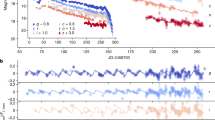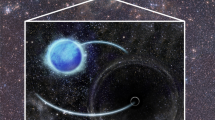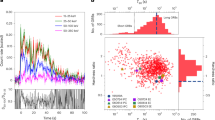Abstract
The existence of a ‘density cusp’1,2—a localized increase in number—of stellar-mass black holes near a supermassive black hole is a fundamental prediction of galactic stellar dynamics3. The best place to detect such a cusp is in the Galactic Centre, where the nearest supermassive black hole, Sagittarius A*, resides. As many as 20,000 black holes are predicted to settle into the central parsec of the Galaxy as a result of dynamical friction3,4,5; however, so far no density cusp of black holes has been detected. Low-mass X-ray binary systems that contain a stellar-mass black hole are natural tracers of isolated black holes. Here we report observations of a dozen quiescent X-ray binaries in a density cusp within one parsec of Sagittarius A*. The lower-energy emission spectra that we observed in these binaries is distinct from the higher-energy spectra associated with the population of accreting white dwarfs that dominates the central eight parsecs of the Galaxy6. The properties of these X-ray binaries, in particular their spatial distribution and luminosity function, suggest the existence of hundreds of binary systems in the central parsec of the Galaxy and many more isolated black holes. We cannot rule out a contribution to the observed emission from a population (of up to about one-half the number of X-ray binaries) of rotationally powered, millisecond pulsars. The spatial distribution of the binary systems is a relic of their formation history, either in the stellar disk around Sagittarius A* (ref. 7) or through in-fall from globular clusters, and constrains the number density of sources in the modelling of gravitational waves from massive stellar remnants8,9, such as neutron stars and black holes.
This is a preview of subscription content, access via your institution
Access options
Access Nature and 54 other Nature Portfolio journals
Get Nature+, our best-value online-access subscription
$29.99 / 30 days
cancel any time
Subscribe to this journal
Receive 51 print issues and online access
$199.00 per year
only $3.90 per issue
Buy this article
- Purchase on Springer Link
- Instant access to full article PDF
Prices may be subject to local taxes which are calculated during checkout




Similar content being viewed by others
References
Bahcall, J. N. & Wolf, R. A. Star distribution around a black hole in a globular cluster. Astrophys. J. 209, 214–232 (1976)
Bahcall, J. N. & Wolf, R. A. Star distribution around a black hole in a globular cluster. II. Unequal star masses. Astrophys. J. 216, 883–907 (1977)
Miralda-Escude, J. & Gould, A. A cluster of black holes at the Galactic Center. Astrophys. J. 545, 847–853 (2000)
Morris, M. Massive star formation near the Galactic Center and the fate of the stellar remnants. Astrophys. J. 408, 496–506 (1993)
Freitag, M. & Amaro-Seoane, P. Stellar remnants in galactic nuclei: mass segregation. Astrophys. J. 649, 91–117 (2006)
Perez, K. et al. Extended hard X-ray emission in the inner few parsecs of the Galaxy. Nature 520, 646–649 (2015)
Levin, Y. & Beloborodov, A. M. Stellar disk in the galactic center — a remnant of a dense accretion disk? Astrophys. J. 590, L33–L36 (2003)
Antonini, F. & Rasio, F. A. Merging black hole binaries in galactic nuclei: implications for Advanced-LIGO detections. Astrophys. J. 831, 187 (2016)
O’Leary, R. M., Kocsis, B. & Loeb, A. Gravitational waves from scattering of stellar-mass black holes in galactic nuclei. Mon. Not. R. Astron. Soc. 395, 2127–2146 (2009)
Reid, M. J. The distance to the center of the Galaxy. Annu. Rev. Astron. Astrophys. 31, 345–372 (1993)
Muno, M. P. et al. A catalog of X-ray point sources from two megaseconds of Chandra observations of the Galactic Center. Astrophys. J. Suppl. Ser. 181, 110–128 (2009)
Remillard, R. A. & McClintock, J. E. X-ray properties of black-hole binaries. Annu. Rev. Astron. Astrophys. 44, 49–92 (2006)
Hailey, C. J. et al. Evidence for intermediate polars as the origin of the Galactic Center hard X-ray emission. Astrophys. J. 826, 160 (2016)
Hong, J., Schlegel, E. M. & Grindlay, J. E. New spectral classification technique for X-ray sources: quantile analysis. Astrophys. J. 614, 508–517 (2004)
Muno, M. P. et al. The spectra and variability of X-ray sources in a deep Chandra observation of the Galactic Center. Astrophys. J. 613, 1179–1201 (2004)
Kim, M. et al. Chandra multiwavelength project X-ray point source number counts and cosmic X-Ray background. Astrophys. J. 659, 29–51 (2007)
Degenaar, N. et al. The Swift X-ray monitoring campaign of the center of the Milky Way. J. High Energy Astrophys. 7, 137–147 (2015)
Degenaar, N. et al. A four-year XMM-Newton/Chandra monitoring campaign in the Galactic Centre: analysing the X-ray transients. Astron. Astrophys. 545, A49 (2012)
Bartko, H. et al. An extremely top-heavy IMF in the Galactic Center stellar disks. Astrophys. J. 708, 834–840 (2010)
Mauerhan, J. C. et al. Near-infrared counterparts to Chandra X-ray sources toward the Galactic Center. I. Statistics and a catalog of candidates. Astrophys. J. 703, 30–41 (2009)
Laycock, S. et al. Constraining the nature of the Galactic Center X-ray source population. Astrophys. J. 634, L53–L56 (2005)
Sazonov, S., Sunyaev, R. & Revnivtsev, M. Coronal radiation of a cusp of spun-up stars and the X-ray luminosity of Sgr A*. Mon. Not. R. Astron. Soc. 420, 388–404 (2012)
Plotkin, R. M. et al. The X-ray spectral evolution of galactic black hole X-ray binaries toward quiescence. Astrophys. J. 773, 59 (2013)
Bogdanov, S. et al. Chandra X-Ray observations of 19 millisecond pulsars in the globular cluster 47 Tucanae. Astrophys. J. 646, 1104–1115 (2006)
Muno, M. P. et al. An overabundance of transient X-ray binaries within 1 parsec of the Galactic Center. Astrophys. J. 622, L113–L116 (2005)
Hopman, C. Binary dynamics near a massive black hole. Astrophys. J. 700, 1933–1951 (2009)
Christopher, M. H. et al. HCN and HCO+ observations of the Galactic circumnuclear disk. Astrophys. J. 622, 346–365 (2005)
Alexander, T. & Hopman, C. The effect of mass segregation on gravitational sources near massive black holes. Astrophys. J. 645, L133–L136 (2006)
Alexander, T. & Hopman, C. Strong mass segregation around a massive black hole. Astrophys. J. 697, 1861–1869 (2009)
Merritt, D. The distribution of stars and stellar remnants at the Galactic Center. Astrophys. J. 718, 739–761 (2010)
Broos, P. S. et al. Innovations in the analysis of Chandra-ACIS observations. Astrophys. J. 714, 1582–1605 (2010)
Arnaud, K. A. XSPEC: the first ten years. ASP Conf. Ser. 101, 17–20 (1996)
Wilms, J., Allen, A. & McCray, R. On the absorption of X-rays in the interstellar medium. Astrophys. J. 542, 914–924 (2000)
Davis, J. E. et al. Raytracing with MARX: X-ray observatory design, calibration, and support. Proc. SPIE 8443, 84431A (2012)
Hong, J. et al. NuSTAR hard X-ray survey of the galactic center region. II. X-ray point Sources. Astrophys. J. 825, 132 (2016)
Sakano, M. et al. Unusual X-ray transients in the Galactic Centre. Mon. Not. R. Astron. Soc. 357, 1211–1218 (2005)
Ponti, G. et al. A powerful flare from Sgr A* confirms the synchrotron nature of the X-ray emission. Mon. Not. R. Astron. Soc. 468, 2447–2468 (2017)
Takata, J., Cheng, K. S. & Taam, R. E. X-ray and gamma-ray emissions from different evolutionary stage of rotation powered millisecond pulsars. Astrophys. J. 745, 100 (2012)
Kaspi, V. M. & Beloborodov, A. M. Magnetars. Annu. Rev. Astron. Astrophys. 55, 261–301 (2017)
Rockefeller, G., Fryer, C. L., Baganoff, F. K. & Melia, F. The X-ray ridge surrounding Sagittarius A* at the Galactic Center. Astrophys. J. 635, L141–L144 (2005)
Overbeck, J. W. Small-angle scattering of celestial X-rays by interstellar grains. Astrophys. J. 141, 864–866 (1965)
Jin, C. et al. Probing the interstellar dust towards the Galactic Centre: dust-scattering halo around AX J1745.6−2901. Mon. Not. R. Astron. Soc. 468, 2532–2551 (2017)
Corrales, L. R. et al. The Chandra dust-scattering halo of Galactic Center transient Swift J174540.7−290015. Astrophys. J. 839, 76 (2017)
Corrales, L. et al. The dust-scattering component of X-ray extinction: effects on continuum fitting and high-resolution absorption edge structure. Mon. Not. R. Astron. Soc. 458, 1345–1351 (2016)
Bradley, C. K. The spectrum of the black hole X-ray nova V404 Cygni in quiescence as measured by XMM-Newton. Astrophys. J. 667, 427–432 (2007)
Scargle, J. D., Norris, J. P., Jackson, B. & Chiang, J. Studies in astronomical time series analysis. VI. Bayesian block representations. Astrophys. J. 764, 167 (2013)
Overbeck, J. W. Small-angle scattering of celestial X-rays by interstellar grains. Astrophys. J. 141, 864–866 (1965)
Bogdanov, S. et al. Chandra X-ray observations of the 12 millisecond pulsars in the globular cluster M28. Astrophys. J. 730, 81 (2011)
Schödel, R. et al. The distribution of stars around the Milky Way’s central black hole. II. Diffuse light from sub-giants and dwarfs. Astron. Astrophys. https://doi.org/10.1051/0004-6361/201730452 (2017)
Armas Padilla, M. et al. Swift J1357.2−0933: the faintest black hole? Mon. Not. R. Astron. Soc. 444, 902–905 (2014)
Casares, J. et al. A Be-type star with a black-hole companion. Nature 505, 378–381 (2014)
Acknowledgements
This work was partially supported by NASA contract no. NNG08FD60C. We thank P. Broos of the Chandra ACIS Instrument Team at Penn State for help with the ACIS Extract Package, and D. P. Huenemoerder and H. M. Guenther at MIT for help with the MARX simulation tool. We acknowledge C. Jin and G. Ponti for providing the dust scattering model. We thank A. Generozov, D. Helfand, L. Hui, S. Mandel, B. Metzger, J. Ostriker and N. Stone of Columbia University and Q. D. Wang at the University of Massachusetts at Amherst for discussions. F.E.B. acknowledges support from CONICYT-Chile (Basal-CATA PFB-06/2007, FONDECYT Regular 1141218), the Ministry of Economy, Development, and Tourism’s Millennium Science Initiative through grant IC120009, awarded to The Millennium Institute of Astrophysics, MAS.
Author information
Authors and Affiliations
Contributions
C.J.H., statistical and population analysis, interpretation and manuscript preparation; K.M., image and spectral analysis, interpretation and manuscript preparation; F.E.B., source extraction, MARX simulations and review; M.E.B., image, spectral and statistical analysis, MARX simulations and review; J.H., source extraction, MARX simulations and review; and B.J.H., image, spectral and population analysis, XSPEC simulations and review.
Corresponding author
Ethics declarations
Competing interests
The authors declare no competing financial interests.
Additional information
Reviewer Information Nature thanks F. Baganoff, J. Miralda-Escudé and M. Morris for their contribution to the peer review of this work.
Publisher's note: Springer Nature remains neutral with regard to jurisdictional claims in published maps and institutional affiliations.
Extended data figures and tables
Extended Data Figure 1 Example Chandra spectra of thermal and non-thermal X-ray sources.
a, CXO J174541.02−290017.6 (HR2 > 0.3). b, CXO J174539.48−290045.8 (HR2 < 0.3). The hard (thermal) source spectrum, which exhibits a broad emission line at E = 6–7 keV, is fitted by a partially covered APEC model, whereas the soft (non-thermal) source spectrum is fitted by an absorbed power-law model. The error bars represent 1σ statistical uncertainties. The bottom panels show residuals (data minus model) in terms of 1σ significance.
Extended Data Figure 2 A cumulative X-ray flux distribution of the qBH-LMXB candidates within 1 pc.
A logN–logS histogram of the 12 HR2 < 0.3 sources (assuming all are qBH-LMXBs) is plotted, where S denotes an absorbed 2–8-keV flux. The best-fitting power-law model is shown as a solid blue line. An extrapolation of this line to the minimum observed flux (1.9 × 10−16 erg cm−2 s−1, after correcting for higher X-ray extinction in the Galactic Centre) of the local qBH-LMXB population50 is used to estimate the total number of qBH-LMXBs in the central parsec.
Extended Data Figure 3 Hardness ratio for X-ray point sources with C ≥ 100 as a function of the projected radial distance from Sgr A*.
The horizontal line denotes the best fit to a radially constant hardness ratio (HR2 = 0.53), which yields a poor fit with  for 89 d.o.f. We took into account statistical and systematic errors in the HR2 data; the error bars in the figure indicate 1σ statistical uncertainties. The hypothesis of spatial constancy of HR2 is thus rejected with P = 1.1 × 10−19. The bifurcation in HR2 at r ≲ 1 pc is clearly visible.
for 89 d.o.f. We took into account statistical and systematic errors in the HR2 data; the error bars in the figure indicate 1σ statistical uncertainties. The hypothesis of spatial constancy of HR2 is thus rejected with P = 1.1 × 10−19. The bifurcation in HR2 at r ≲ 1 pc is clearly visible.
Extended Data Figure 4 Chandra images of the soft source CXO J174540.79−290024.5 and its extracted background events.
a, Neighborhood image around the source (labelled 26, with multiple green circles near the centre indicating source extraction regions for different observations) along with other Chandra catalogue sources indicated by numbers 23, 24 and 27. b, Background image around the source (labelled 26 and located near the centre with a green circle) from ObsID 11843. The red dashed circle indicates the inner circle of the background annulus (r = 2.5″). Note that background was properly extracted from an annulus of r ≈ 2.5″–4″ by excluding the nearby Chandra sources indicated by green circles labelled 23, 24 and 27.
Extended Data Figure 5 Colour–colour diagram of X-ray sources with C ≥ 100 within radial projected distances from Sgr A*.
HR2 and HR3 hardness data are plotted for sources at r < 1 pc (cyan) and 1 pc < r < 3.8 pc (red). The error bars represent 1σ statistical uncertainties. There is no clear evidence of HR3–HR2 correlation, a surrogate for column-density- or scattering-related effects. The vertical dotted grey line indicates our dividing line at HR2 = 0.3 between the soft and hard sources. For reference, the calculated HR2 and HR3 for four local IPs, whose spectra were extrapolated to the distance of Sgr A*, are shown as black diamonds. They cluster at high HR2, as expected. Only three of the four IP diamonds are visible because two of them overlap.
Extended Data Figure 6 Median photon energy in the spectrum versus hardness ratio of X-ray sources with C ≥ 100.
Sources for r < 1 pc and r > 1 pc are indicated in cyan and red, respectively. The median m = Q50 and the ratio of two quartiles Q25/Q75 are calculated for each source14. The energy scale across the top shows the median energy values (E50%). The blue and red lines correspond to hydrogen column density NH and power-law photon index Γ grids, respectively. The error bars represent 1σ statistical uncertainties.
Extended Data Figure 7 Stacked Chandra ACIS-I spectrum of the 14 thermal X-ray sources with net counts C ≥ 100 within r < 1 pc.
The spectrum is well fitted with a partially covered thermal APEC model with a Gaussian line at 6.4 keV ( for 58 d.o.f.). The error bars represent 1σ statistical uncertainties. The bottom panels show residuals (data minus model) in terms of 1σ significance. The best-fit parameters are shown in Extended Data Table 2.
for 58 d.o.f.). The error bars represent 1σ statistical uncertainties. The bottom panels show residuals (data minus model) in terms of 1σ significance. The best-fit parameters are shown in Extended Data Table 2.
Extended Data Figure 8 Stacked background Chandra ACIS-I spectra of the sources with net counts C ≥ 100 within r < 1 pc.
a, 12 HR2 < 0.3 sources. b, 14 HR2 > 0.3 sources. Several prominent emission lines are present from low-Z elements (below 4 keV) and Fe (at 6–7 keV). Both background spectra are well fitted with an absorbed two-temperature thermal APEC model:  (291 d.o.f.; soft source background) and
(291 d.o.f.; soft source background) and  (320 d.o.f.; hard source background). The best-fit temperatures are consistent between the two background spectra:
(320 d.o.f.; hard source background). The best-fit temperatures are consistent between the two background spectra:  and
and  (for the soft source background) and
(for the soft source background) and  and
and  (for the hard source background). The error bars represent 1σ statistical uncertainties. The bottom panels show residuals (data minus model) in terms of 1σ significance.
(for the hard source background). The error bars represent 1σ statistical uncertainties. The bottom panels show residuals (data minus model) in terms of 1σ significance.
Extended Data Figure 9 Simulated Chandra ACIS-I spectrum using a two-temperature thermal APEC model.
The input parameters are kT1 = 1.0 keV and Z1 = 2.5 (for the lower-temperature component) and kT2 = 5.0 keV and Z2 = 0.6 (for the higher-temperature component). The spectrum was poorly fit with an absorbed power-law model yielding  (56 d.o.f.; hard source background) and showing large residuals at 2–3 keV and 6–7 keV. The best-fit photon index (
(56 d.o.f.; hard source background) and showing large residuals at 2–3 keV and 6–7 keV. The best-fit photon index ( ) is significantly softer than that of the stacked soft source spectrum in Fig. 2b (
) is significantly softer than that of the stacked soft source spectrum in Fig. 2b ( ).
).
Rights and permissions
About this article
Cite this article
Hailey, C., Mori, K., Bauer, F. et al. A density cusp of quiescent X-ray binaries in the central parsec of the Galaxy. Nature 556, 70–73 (2018). https://doi.org/10.1038/nature25029
Received:
Accepted:
Published:
Issue Date:
DOI: https://doi.org/10.1038/nature25029
This article is cited by
-
Understanding the origin of the positron annihilation line and the physics of supernova explosions
Experimental Astronomy (2021)
-
Bounteous black holes at the Galactic Centre
Nature (2018)
Comments
By submitting a comment you agree to abide by our Terms and Community Guidelines. If you find something abusive or that does not comply with our terms or guidelines please flag it as inappropriate.



